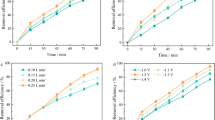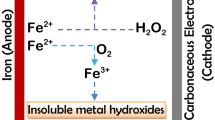Abstract
Formaldehyde (HCHO) is a common chemical raw material and one of the major constituents in wastewaters from the production of chemical products. HCHO in wastewater is mainly removed by adsorption, biodegradation, and advanced oxidation. The objective of this study is to investigate transition metal oxides (Fe2O3, Co2O3, Ni2O3, CuO, ZnO) without pretreatment for enhancing the oxidation of HCHO. The oxidation of HCHO in wastewater by hydrogen peroxide using transition metal oxides as catalysts is studied. The concentration of HCHO in waste water was measured by indirect method. HCHO reacts with 2,4-dinitrophenylhydrazine in the presence of acetic acid to produce 2,4-dinitrophenylhydrazone. 2,4-Dinitrophenylhydrazone increases in proportion to the concentration of HCHO. The HCHO removal rate is determined by quantitative analyses of 2,4-dinitrophenylhydrazone using high-performance liquid chromatography (HPLC). The catalytic oxidation experiments are performed in test tubes at 25°C. The results indicate that the catalytic activity of the transition metal oxides towards HCHO oxidation is very different. The removal rate of HCHO was attributed to the number of hydroxyl radicals formed in the system. CuO shows higher catalytic activity in the oxidation of HCHO. The effect of the temperature, the mole ratios of hydrogen peroxide to HCHO, and the amount of CuO on the removal rate of HCHO were studied. Results of experiments show that the HCHO is almost wholly oxidized (>98%) at the best conditions (molar ratio of hydrogen peroxide to HCHO is 2.5, CuO is 0.06 g, 25°C for 15 min). CuO also offers the advantages of simple recovery from the treated solution and repeated use. It is hypothesized that CuO can transform hydrogen peroxide into active oxygen that has higher oxidation activity. But, the rate of formation and removal of free radicals HO· is very fast in the presence of transition metal oxides (Fe2O3, Co2O3, Ni2O3, ZnO).




Similar content being viewed by others
REFERENCES
Cheng, Y., Sui, G., and Liu, H., Preparation of highly phenol substituted bio-oil–phenol–formaldehyde adhesives with enhanced bonding performance using furfural as crosslinking agent, J. Appl. Polym. Sci., 2018, vol. 136, no. 4, 46995.
Chang, J., Guo, Z., and Fortmann, R., Characterization and reduction of formaldehyde emissions from a low-VOC latex paint, Indoor Air, 2002, vol. 12, no. 1, pp. 10–16.
Mustata, F. and Bicu, I., Formaldehyde resins bearing diaminodiphenylmethane groups: Synthesis, characterization and properties, Macromol. Mater. Eng., 2010, vol. 289, no. 9, pp. 800–808.
Scheman, A.J., Carroll, P.A., Brown, K.H., and Osburn, A.H., Formaldehyde-related textile allergy: An update, Contact Dermatitis, 1998, vol. 38, no. 6, pp. 332–336.
Lin, Z.F., Tong, X., Shen, W.H., Rou, J.C., and Xi, H.X., Humidity impact on photo-catalytic degradation: Adsorption behavior simulations and catalytic reaction mechanisms for main gaseous pollutants in papermaking industry, J. Cleaner Prod., 2020, vol. 244, 118863.
Machado, A.E.H., Xavier, T.P., Souza, D.R., Miranda, J.A., Duarte, E.T.F.M., Ruggiero, R., Oliveira, L., and Sattler, C., Solar photo-Fenton treatment of chip board production waste water, Sol. Energy, 2004, vol. 77, pp. 583–589.
Chuang, C.S., Wu, C.Y., Wu, K.C., and Sheen, H.J., Flame retardancy of water-based intumescent coatings with etherified melamine-formaldehyde and polyvinyl acetate copolymer hybrid resin, J. Appl. Polym. Sci., 2020, vol. 137, no. 31, 49279.
Sánchez-Martín, J., Beltrán-Heredia, J., and Carmona-Murillo, C., Adsorbents from Schinopsis balansae: Optimisation of significant variables, Ind. Crop. Prod., 2011, vol. 33, pp. 409–417.
Pereira, A.L.S., Feitosa, J.P.A., Morais, J.P.S., and Rosa, M.F., Bacterial cellulose aerogels: Influence of oxidation and silanization on mechanical and absorption properties, Carbohydr. Polym., 2020, vol. 250, 116927.
Khamkeaw, A., Synthesis of mesoporous MFI zeolite via bacterial cellulose-derived carbon templating for fast adsorption of formaldehyde, J. Hazard Mater., 2020, vol. 384, 121161.
Mei, X., Guo, Z.W., Liu, J., Bi, S.Q., Li, P.P., Wang, Y., Shen, W.T., and Yang, Y., Treatment of formaldehyde wastewater by a membrane-aerated biofilm reactor (MABR): The degradation of formaldehyde in the presence of the cosubstrate methanol, Chem. Eng. J., 2019, vol. 372, pp. 673–683.
Vakylabad, A.B., Treatment of highly concentrated formaldehyde effluent using adsorption and ultrasonic dissociation on mesoporous copper iodide (CuI) nano-powder, J. Environ. Manage., 2021, vol. 285, 112085.
Oliveira, S.V.W.B., Moraes, E.M., Adorno, M.A.T., Varesche, M.B.A., Foresti, E., and Zaiat, M., Formaldehyde degradation in an anaerobic packed-bed bioreactor, Water Res., 2004, vol. 38, pp. 1685–1694.
Agarwal, S., Ferreira, A.E., Reis, M.T.A., Ismael, M.R.C., Ferreira, L.M., Machado, R.M., and Carvalho, J.M.R., A study on a combined process for the treatment of phenolic resin plant effluents, J. Hazard Mater., 2009, vol. 169, pp. 659–666.
Yang, X., Zhao, H.Q., Qu, Z.B., He, M.Q., Tang, Z.Y., Lai, S.W., and Wang, Z.H., The effect of oxygen-containing functional groups on formaldehydeadsorption in solution on carbon surface: A density functional theory study, J. Environ. Chem. Eng., 2021, vol. 9, 105987.
Shen, Y.B., Ning, F.D., Zhan, Y.L., Bai, C., and Wang, H.H., Polypyrrole-immobilized organo iridium for formaldehyde efficient decomposition in water and air, Appl. Catal., A, 2020, vol. 602, 117667.
Ivanets, A., Prozorovich, V., Sarkisov, V., Roshchina, M., Grigoraviciute-Puroniene, I., Zarkov, A., Kareiva, A., Masindi, V., Wang, C., Srivastava, V., and Sillanpää, M., Effect of magnesium ferrite doping with lanthanide ions on dark-, visible-and UV-driven Methylene Blue degradation on heterogeneous Fenton-like catalysts, Ceram. Int., 2021, vol. 47, pp. 29786–29794.
Ivanets, A., Prozorovich, V., Roshchina, M., Grigoraviciute-Puroniene, I., Zarkov, A., Kareiva, A., Wang, Z., Srivastava, V., and Sillanpää, M., Heterogeneous Fenton oxidation using magnesium ferrite nanoparticles for ibuprofen removal from wastewater: Optimization and kinetics studies, J. Nanomater., 2020, vol. 2020, 8159628.
Lousada, C.M., Yang, M., Nilsson, K., and Jonsson, M., Catalytic decomposition of hydrogen peroxide on transition metal and lanthanide oxides, J. Mol. Catal. A: Chem., 2013, vol. 379, pp. 178–184.
Lousada, C.M., Johansson, A.J., Brinck, T., and Jonsson, M., Mechanism of H2O2 decomposition on transition metal oxide surfaces, J. Phys. Chem. C, 2012, vol. 116, pp. 9533–9543.
Ivanets, A., Roshchina, M., Srivastava, V., Prozorovich,V., Dontsova, T., Nahirniak, S., Pankov, V., Hosseini-Bandegharaei, A., Nguyen Tran, H., and Sillanpää, M., Effect of metal ions adsorption on the efficiency of Methylene Blue degradation onto MgFe2O4 as Fenton-like catalysts, Colloid Surf., A, 2019, vol. 571, no. 2, pp. 17–26.
Gemeay, A.H., Catalytic activity of silica gel surface modified by transition metal-aminosilane complexes in the decomposition of hydrogen peroxide, Colloid Surf., A, 1996, vol. 116, pp. 277–284.
Baldrian, P., Merhautova, V., Cajthaml, T., Nerud, F., Stopka, P., Gorbacheva, O., Hruby, M., and Benes, M.J., Synthesis of zirconia-immobilized copper chelates for catalytic decomposition of hydrogen peroxide and the oxidation of polycyclic aromatic hydrocarbons, Chemosphere, 2008, vol. 72, pp. 1721–1726.
Funding
This study was supported by Scientific and Technological Innovation Programs of Higher Education Institutions in Shanxi (grant no. 2019L0919). This work was also supported by the Fund for Shanxi “1331 Project” and the National Natural Science Fund of China (grant no. 22072105).
Author information
Authors and Affiliations
Contributions
Conceptualization and Methodology: Qingguo Ma; Formal analysis and investigation: Qingguo Ma, Yu Hao, Yanfeng Xue, Yulan Niu, Xiliang Chang; Writing—original draft preparation: Qingguo Ma, Yu Hao; Writing—review and editing: Qingguo Ma, Yanfeng Xue; Funding acquisition: Qingguo Ma, Yanfeng Xue; Resources: Qingguo Ma, Yulan Niu.
Corresponding author
Ethics declarations
The authors declare that they have no conflicts of interest.
About this article
Cite this article
Ma, Q.G., Hao, Y., Xue, Y.F. et al. Removal of Formaldehyde from Aqueous Solution by Hydrogen Peroxide. J. Water Chem. Technol. 44, 297–303 (2022). https://doi.org/10.3103/S1063455X22040099
Received:
Revised:
Accepted:
Published:
Issue Date:
DOI: https://doi.org/10.3103/S1063455X22040099




